Table A. Summary of External Trade Performance February 2021r, January 2022r, and February 2022p
| Indicator | February 2021r | January 2022r | February 2022p | |||
| FOB Value (in million USD) |
Year-on-Year Growth (%) |
FOB Value (in million USD) |
Year-on-Year Growth (%) |
FOB Value (in million USD) |
Year-on-Year Growth (%) |
|
| Total Trade | 13,421.18 | 4.6 | 16,807.79 | 20.3 | 15,847.33 | 18.1 |
| Balance of Trade | -2,707.71 | 37.6 | -4,715.91 | 63.9 | -3,529.03 | 30.3 |
| Exports | 5,356.73 | -1.4 | 6,045.94 | 9.0 | 6,159.15 | 15.0 |
| Imports | 8,064.45 | 9.0 | 10,761.85 | 27.7 | 9,688.18 | 20.1 |
| p – preliminary, r – revised Source: Philippine Statistics Authority |
||||||
A. TOTAL EXTERNAL TRADE AND BALANCE OF TRADE
1. Total external trade increased
In February 2022, the country’s total external trade in goods amounted to USD 15.85 billion which indicates an annual growth rate of 18.1 percent. In the previous month, the annual increase was faster at 20.3 percent, while in February 2021, it grew by 4.6 percent. (Table A)
Of the total external trade in February 2022, 61.1 percent were imported goods, while the rest were exported goods.
2. Trade deficit posted an annual increase
Balance of trade in goods (BoT-G) is the difference between the value of export and import. BoT-G in February 2022 amounted to USD -3.53 billion, indicating a trade deficit with an annual increase of 30.3 percent. The trade deficit in the previous month recorded an annual increase of 63.9 percent, while in February 2021, it was at 37.6 percent. (Figure 1, Tables A and 2)
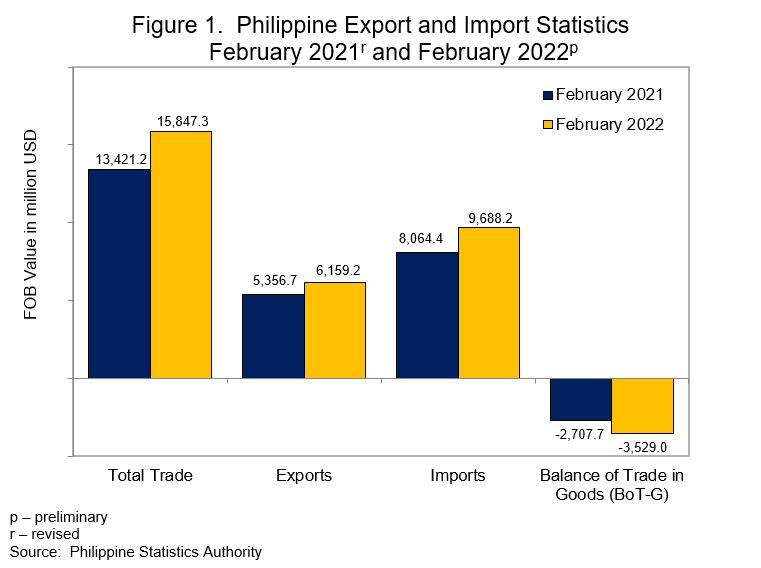
B. EXPORTS
1. Sales from export posted a positive growth
The country’s total export sales in February 2022, amounting to USD 6.16 billion, increased at an annual rate of 15.0 percent, from an increment of 9.0 percent in the previous month. In February 2021, total export sales decreased at an annual rate of -1.4 percent. (Figures 1 and 2, Tables A and 2)
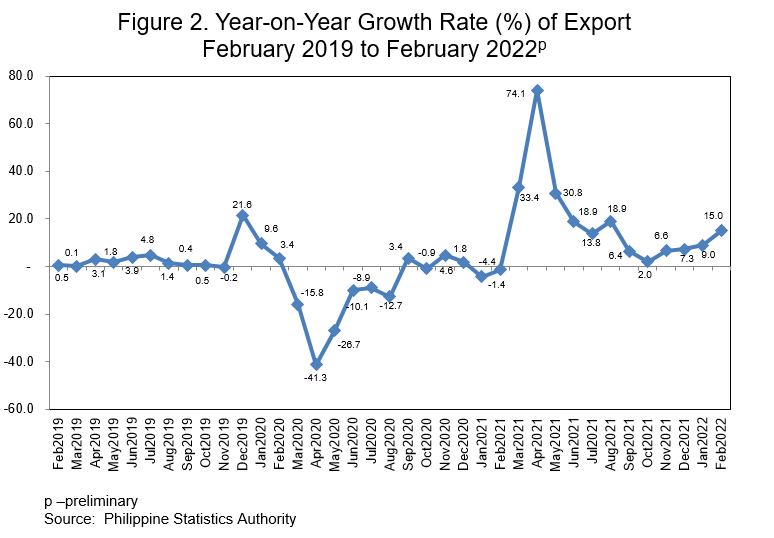
Of the top 10 major commodity groups in terms of the value of exports, eight recorded annual increases which was led by cathodes and sections of cathodes, of refined copper (130.2%). This was followed by coconut oil (118.2%), and other mineral products (27.5%). (Tables B and 3)
Table B. Year-on-Year Growth Rate of Value of Philippine Exports for Top Ten Major Commodity Groups: February 2022p
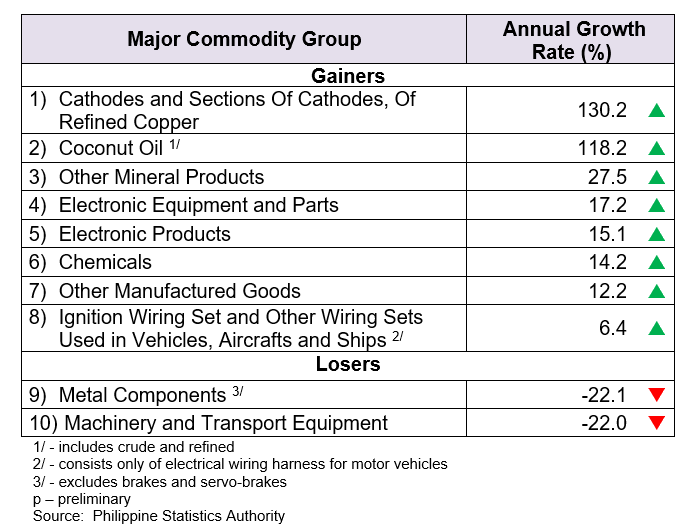
2. Year-to-date annual total export increased
The year-to-date annual total export earnings, that is from January 2022 to February 2022, amounted to USD 12.21 billion. This represents an annual increase of 11.9 percent compared with the year-to-date annual total export value earned in January 2021 to February 2021. (Table 4)
3. Electronic products commodity group remained the highest on export sales
By commodity group, electronic products continued to be the country’s top export in February 2022 with total earnings of USD 3.44 billion. This amount accounted for 55.9 percent of the total exports during the period. This was followed by other manufactured goods with an export value of USD 391.98 million (6.4%); and ignition wiring set and other wiring sets used in vehicles, aircrafts and ships which amounted to USD 204.82 million (3.3%). (Figure 3 and Table 3)
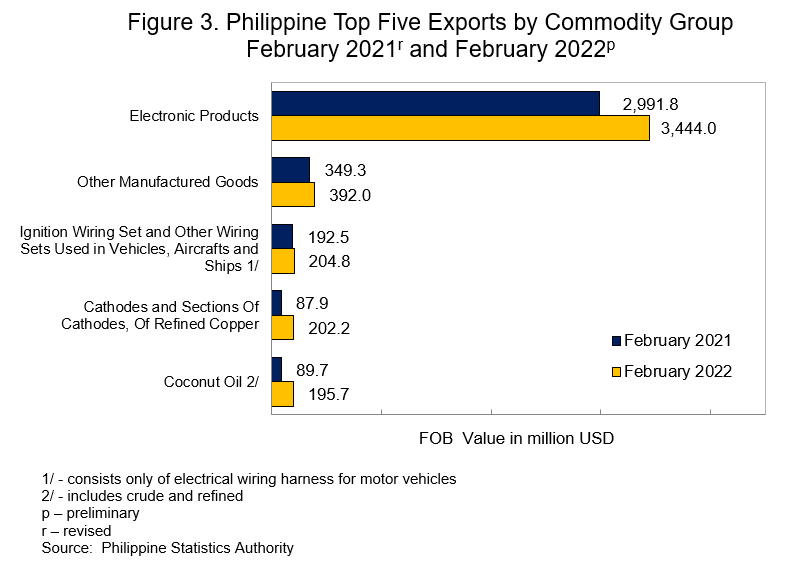
4. Manufactured goods still comprised the biggest chunk of total exports among major types of goods
By major type of goods, exports of manufactured goods shared the biggest to the total exports in February 2022 amounting to USD 5.03 billion (81.7%). This was followed by mineral products with a share of USD 504.76 million (8.2%); and total agro-based products which contributed USD 501.53 million (8.1%). (Figure 4 and Table 5)
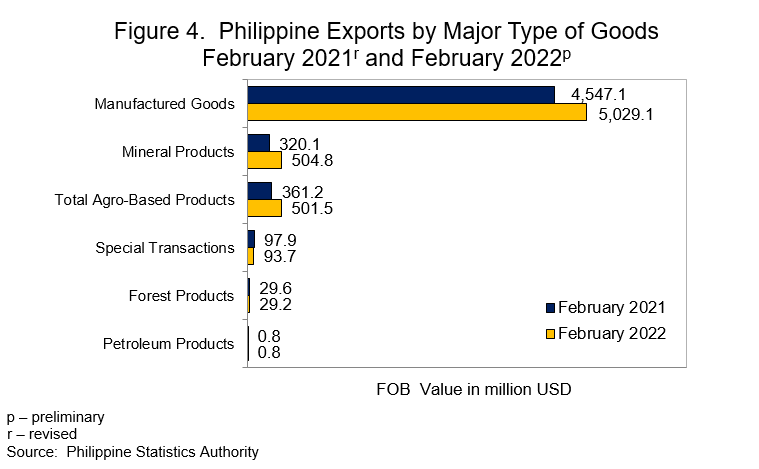
5. Total export value of Personal Protective Equipment (PPE) and medical supplies decreased in February 2022
The total export value for Personal Protective Equipment (PPE) and medical supplies in February 2022 dropped to USD 0.95 million. This represents an annual decrease of -46.0 percent from its value in February 2021. The annual decrease in the export value for these medical items in the previous month was recorded at -53.0 percent, while it declined by -40.0 percent in February 2021.
The annual decrease in export for surgical face mask at -81.0 percent contributed to the downtrend of export value for PPE and medical supplies in February 2022. On the other hand, export value for other face mask (non-surgical/non-medical masks including masks made of cloth) grew by 46.0 percent
Month-on-month, export value for PPE and medical supplies declined by -28.0 percent in February 2022, while in January 2022, it increased by 24.0 percent.
Contributing to the monthly decrease in the export value of PPE and medical supplies were the declines in the export value of other face mask (non-surgical/non-medical masks including masks made of cloth, -30.0%) and surgical face mask (-26.0%). (Tables C and 7)
Table C. Philippine Exports of Personal Protective Equipment and Medical Supplies: February 2021r, January 2022r, and February 2022p
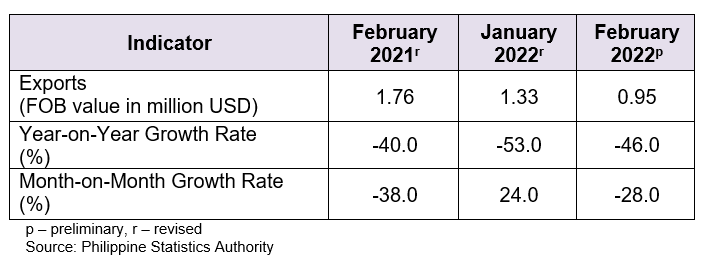
6. United States of America (USA) contributed the highest export value
By major trading partner, exports to the USA comprised the highest export value amounting to USD 966.66 million or a share of 15.7 percent to the total exports during the month.
Completing the top five major export trading partners with their export values and percent shares to the total exports were the following:
- Japan, USD 900.02 million (14.6%);
- People’s Republic of China, USD 805.92 million (13.1%);
- Hong Kong, USD 782.94 million (12.7%); and
- Singapore, USD 409.89 million (6.7%).
(Figure 5 and Table 8)
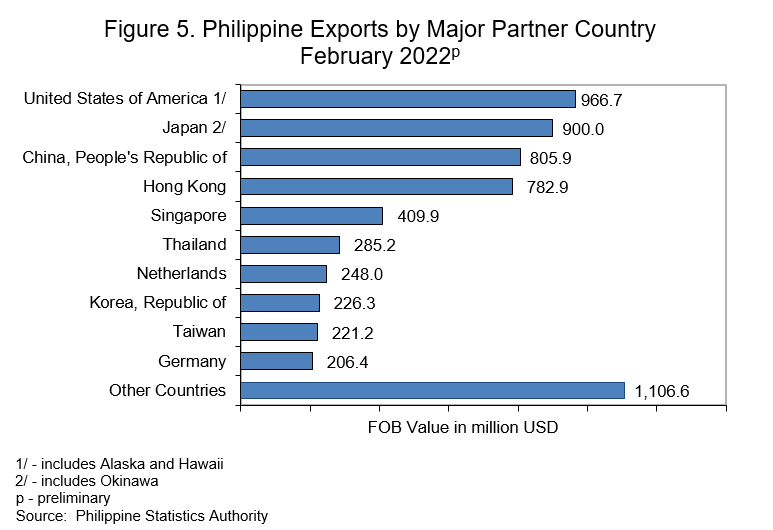
7. Majority of exports were for APEC countries
By economic bloc, majority of the country’s merchandise exports in February 2022 went to the Asia-Pacific Economic Cooperation (APEC) member countries with a share of USD 5.19 billion (84.2%) to total exports. This was followed by East Asia, valued at USD 2.94 billion (47.7%), and the Association of Southeast Asian Nations (ASEAN) at USD 1.15 billion (18.6%). (Figure 6 and Table 9)
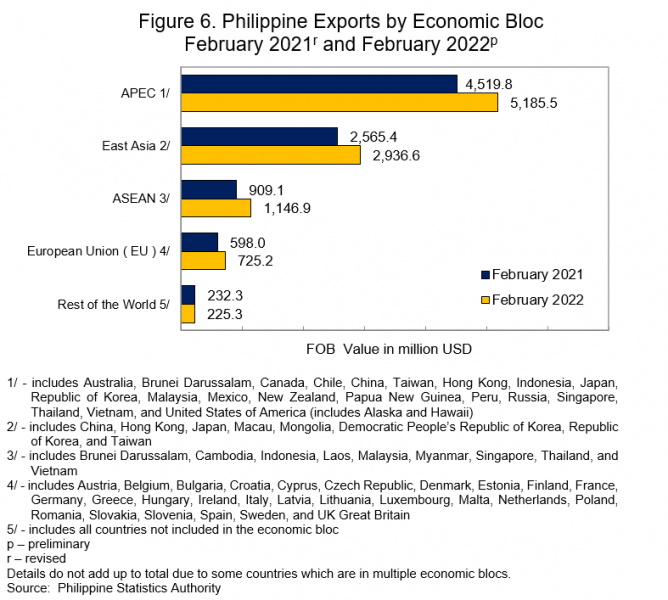
8. Eastern Asia contributed the highest export value by geographic region
By geographic region, Eastern Asia comprised the highest export value amounting to USD 2.94 billion in February 2022. This was followed by Southeastern Asia with an export value of USD 1.15 billion and Northern America with USD 1.01 billion worth of export value. (Figure 7 and Table 19)
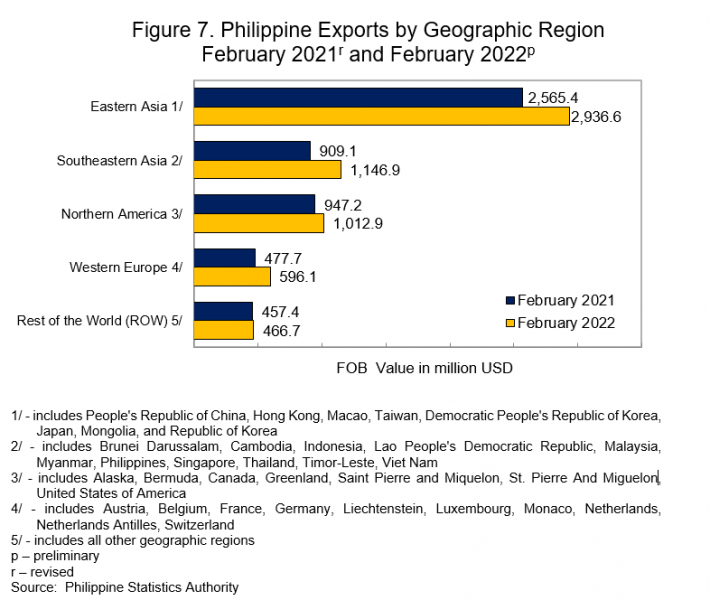
C. IMPORTS
1. Import value increased
Total imported goods in February 2022, which amounted to USD 9.69 billion, increased at an annual rate of 20.1 percent. In January 2022, the annual increase was higher at 27.7 percent, while in February 2021, imports value grew by 9.0 percent annually. (Figures 1 and 8, and Tables A and 2)
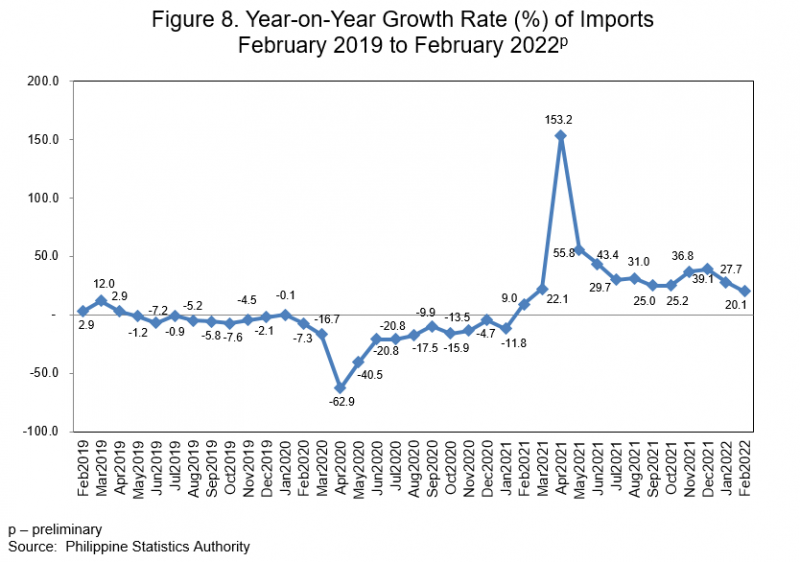
The annual increment of imported goods in February 2022 was due to the increase in six of the top 10 major commodity groups which was led by mineral fuels, lubricants and related materials with 131.6 percent annual increase. This was followed by cereals and cereal preparations which rose by 83.8 percent annually; and other food and live animals, 23.3 percent. (Tables D and 10)
Table D. Year-on-Year Growth Rate of Value of Philippine Imports for Top Ten Major Commodity Groups: February 2022p
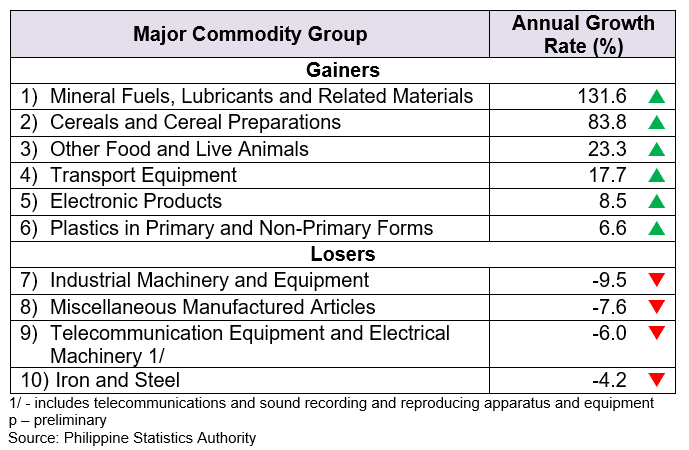
2. Year-to-date annual total import value grew
The year-to-date annual total import value, that is from January 2022 to February 2022, amounted to USD 20.45 billion. This represents an annual increment of 24.0 percent from the year-to-date annual total import value of USD 16.49 billion in January 2021 to February 2021. (Table 11)
3. Electronic products accounted for the highest import value among commodity groups
Most of the imported goods were electronic products with an import value of USD 2.40 billion or a share of 24.8 percent to the total imports in February 2022. This was followed by mineral fuels, lubricants and related materials, valued at USD 1.67 billion (17.2%); and transport equipment which amounted to USD 916.95 million (9.5%). (Figure 9 and Table 10)
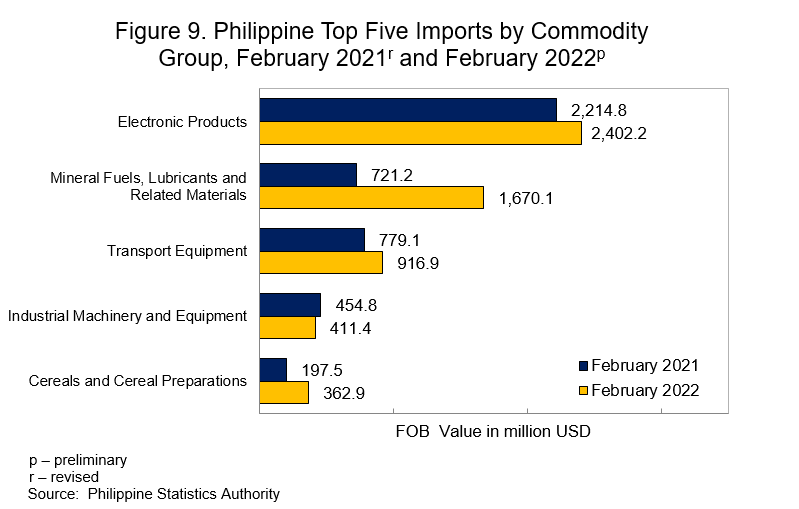
4. Imports of raw materials and intermediate goods contributed the highest among types of goods
By major type of goods, imports of raw materials and intermediate goods accounted for the largest share to the total imports amounting to USD 3.65 billion (37.7%) in February 2022. Imports of capital goods ranked second with a share of USD 2.81 billion (29.0%), followed by mineral fuels, lubricants and related materials with USD 1.67 billion (17.2%).
Imports of mineral fuels, lubricants and related materials recorded a positive annual growth of 131.6 percent from its value in the same month of the previous year. Contributing to the annual increment in this commodity group was the increase in the import value of petroleum products used to run motor vehicles (includes diesel fuel and fuel oils, light oils and preparations, and aviation turbine fuel) with a value of USD 1.21 billion. (Figure 10 and Table 12)
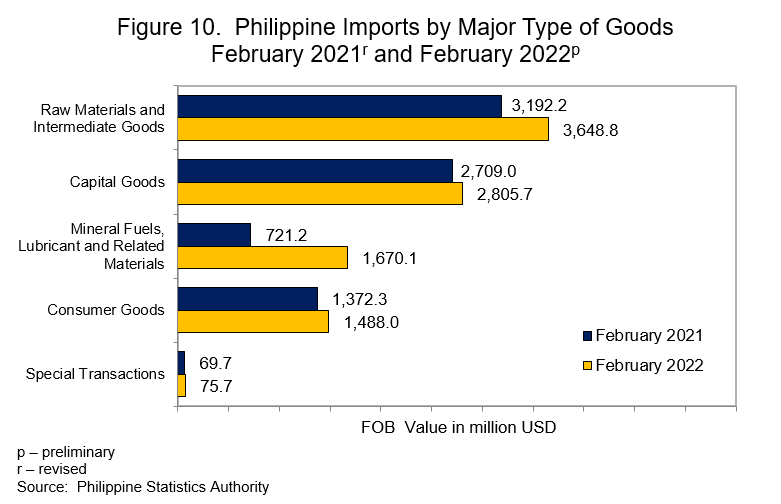
5. Total import value of Personal Protective Equipment (PPE) and medical supplies including COVID-19 vaccine increased in February 2022
The total import value for Personal Protective Equipment (PPE) and medical supplies, including Coronavirus disease 2019 (COVID-19) vaccine, increased to USD 63.55 million in February 2022, indicating an annual increment of 55.3 percent from its value in the same month of the previous year.
In February 2022, the total import for COVID-19 vaccine was valued at USD 40.60 million.
Annual growth rate of import value for PPE and medical supplies, including COVID-19 vaccine, was recorded at 1,101.8 percent in January 2022, while in February 2021, the annual increase was lower at 259.3 percent.
The import value for other face mask (non-surgical/non-medical masks including masks made of cloth) increased by 24.2 percent in February 2022.
Meanwhile, import value decreased year-on-year for the following:
- protective clothing (-97.5%);
- face shield (-83.6%);
- surgical face mask (-79.7%);
- surgical gloves (-60.8%);
- testing kits (-37.8%); and
- safety headgear (-31.5%).
Month-on-month, import value for PPE and medical supplies, including COVID-19 vaccine, decreased by -79.0 percent in February 2022, while it registered a decline of -60.0 percent in the previous month.
Contributing to the monthly drop in the import value of PPE and medical supplies in February 2022, including COVID-19 vaccine, were the decreases in the imports of the following:
- COVID-19 vaccine (-85.4%);
- protective clothing (-82.1%);
- surgical gloves (-71.9%); and
- safety headgear (-25.1%);
On the other hand, import values increased month-on-month for face shield (930.1%), surgical face mask (27.6%), testing kits (0.8%), and other face mask (non-surgical/non-medical masks including masks made of cloth, 0.05%). (Tables E and 14)
Table E. Philippine Imports of Personal Protective Equipment and Medical Supplies: February 2021r, January 2022r, and February 2022p

6. People’s Republic of China had the highest import value
The People’s Republic of China was the country’s biggest supplier of imported goods valued at USD 1.77 billion or 18.3 percent of the total imports in February 2022.
Completing the top five major import trading partners with their corresponding import values and percent shares to the total imports were the following:
- Republic of Korea, USD 1.05 billion (10.8%);
- Japan, USD 908.06 million (9.4%);
- Indonesia, USD 705.26 million (7.3%); and
- USA, USD 610.97 million (6.3%).
(Figure 11 and Table 15)
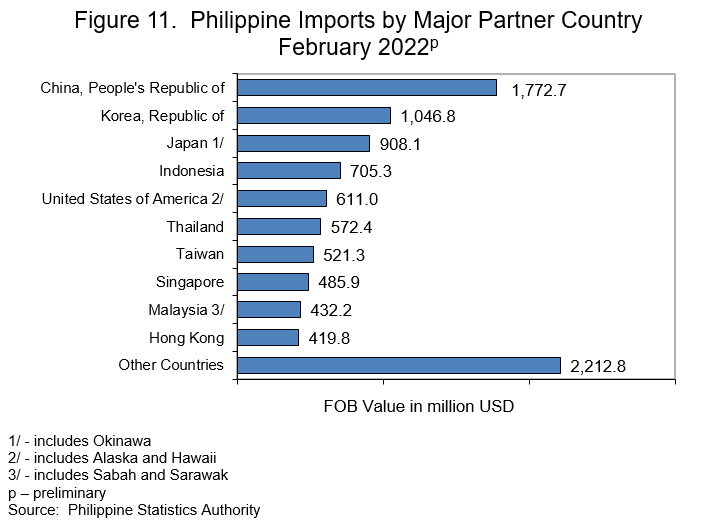
7. Imports came largely from APEC member countries
By economic bloc, APEC member countries were the biggest suppliers of the country’s imported goods in February 2022 with a share of USD 8.23 billion (85.0%). This was followed by East Asia with an import value of USD 4.67 billion (48.2%), and ASEAN with USD 2.50 billion (25.8%). (Figure 12 and Table 16)
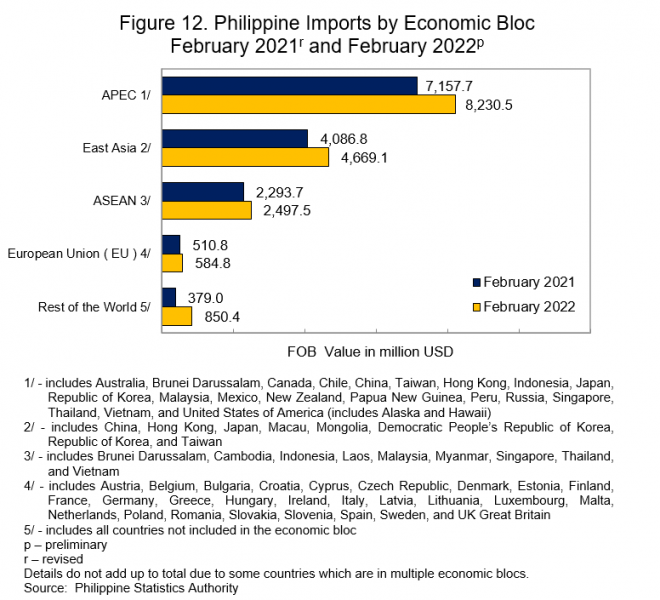
8. Eastern Asia contributed the highest import value by geographic region
By geographic region, USD 4.67 billion of the country’s imports in February 2022 were from Eastern Asia. This was followed by Southeastern Asia whose import value amounted to USD 2.50 billion and Northern America valued at USD 664.90 million. (Figure 13 and Table 19)
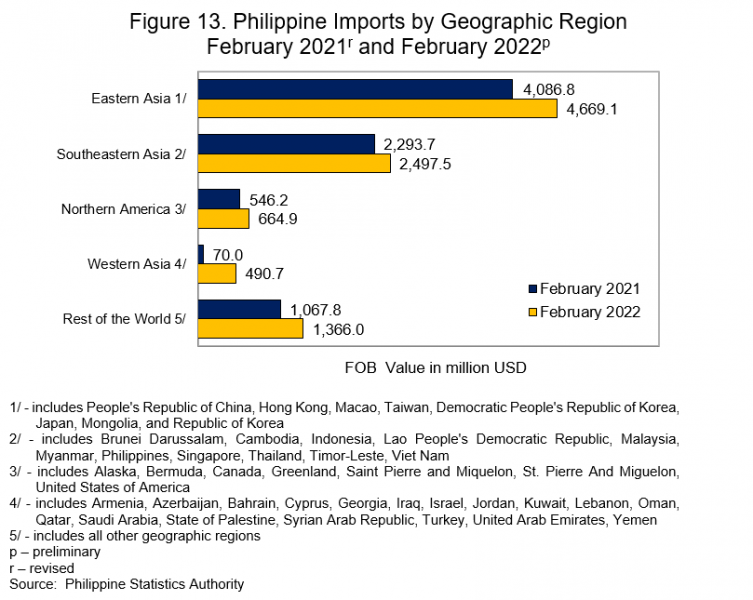
DENNIS S. MAPA, Ph.D.
Undersecretary
National Statistician and Civil Registrar General
Explanatory Notes
Export and import trade statistics are compiled by the Philippine Statistics Authority (PSA) from export and import documents submitted to the Bureau of Customs (BOC) by exporters and importers or their authorized representatives as required by law.
The following are documents collected, either in electronic or hard copies:
- Export Declaration (ED – DTI form);
- Informal Import Declaration and Entry (BOC Form 177); and
- Single Administrative Documents (SAD) for Export Declaration (ED) and Import Entry and Internal Revenue Declaration (IEIRD).
The electronic copies of all documents that pass thru the online system are provided by BOC, Philippine Economic Zone Authority (PEZA), and Value Added Service Providers (VASPs) to PSA on a monthly basis through email and via shared Google Drive.
The electronic copies of the Export Declarations (SAD-ED) from the Automated Export Documentation System (AEDS) of the BOC are being utilized to generate export statistics. The AEDS is a paperless transaction in lieu of the manual filling up of export documents.
Moreover, an electronic copy of the Import Entry and Internal Revenue Declaration (SAD-IEIRD) is utilized to capture the monthly import figures. The SAD-IEIRD is an import document submitted online either by brokers or companies. These are transactions that pass through the Automated Cargo Operating System (ACOS), now called the e2m (electronic to mobile) customs system, which is implemented through the BOC e-Customs Project.
All documents (hard copies and electronic files) received within the cut-off date, which is every 25th day of the month, are compiled, processed, summarized, analyzed, and disseminated through monthly statistical tables and press releases (PRs). Processing includes coding, editing, reviewing, and validating of results.
Preliminary results of export and import statistics are disseminated in the form of press release (PR). The PR is disseminated every 40th day after the reference month. However, if the 40th day falls on a Saturday, the release is made a day earlier (Friday). If it falls on a Sunday or Monday, the release is on Tuesday. Moreover, if the release date falls on a holiday, the date of release is moved accordingly. Preliminary results are posted on the PSA website (www.psa.gov.ph).
All documents received after the cut-off date are included in the generation of the revised results. The revised data of the previous month are reported during the release of the preliminary report of the current month. Revisions are made for the previous months until the annual report is released three months after the reference year.
The 2019 Philippine Standard Commodity Classification (PSCC) is used to classify the commodities at 10-digit code level for statistical purposes.
Data requests on export and import statistics can be made at the PSA, Economic Sector Statistics Service, Trade Statistics Division with telephone number (02) 8376-1975 or email address j.soliven@psa.gov.ph.
